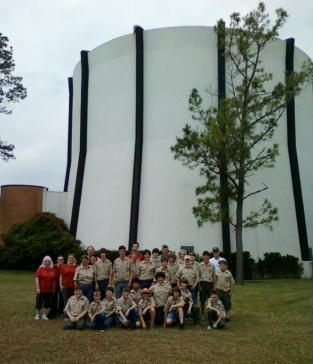Visit us!
We provide tours to fit the needs of educators and others at all levels.

Students (Eighth-grade and above) — from as far away as Houston — visit the Nuclear Engineering & Science Center for a one-hour tour that includes explanations of fission, uses of radioactive material, reactor safety, and more.
Health physics students at technical colleges receive a full day of training on radiation and radioactive material controls at our facility.
Physics students from Texas A&M University and other universities receive detailed explanations and demonstrations of neutron activation analysis.
Schedule a Tour
Tours are free and last about an hour. Special tours can be organized upon request. All participants should wear pants and closed toed shoes while visiting the facility.
Want to schedule a tour? Contact us at least one week prior to the desired tour date to set it up. Tours are not always available, and more notice gives us a better chance of being able to make it happen. If you are looking for other places for tours or visits, see our list of other locations to consider during your visit.
What You’ll Learn
Tours are available to all people with all levels of background in nuclear power and nuclear technology. Whether you’re an eighth-grade student just learning about nuclear science or a professor of nuclear engineering, we want you to visit us.
When you leave the facility, you will know and understand the mystery behind how we get energy from uranium-235, or 235U. The tour guides can provide an in-depth discussion of the transfer of mass to energy and explain how this energy can be used practically to provide power for homes and businesses.
As you learn about the nuclear power process, you will learn how we ensure that reactors are safe. The tour guides can provide a discussion of historical issues with references to the Three Mile Island accident, which hurt no one, and Chernobyl, which hurt many.
Beyond nuclear power, you will learn about the process of making elements radioactive and why we would want to do such a thing — for example, to treat cancer, to produce tracer materials, to identify trace elements, and to irradiate food to make it safe for eating. You will learn about subatomic interactions that allow us to use neutrons to take X-ray-like photos through lead and other heavy materials.
Beyond the science, you will also learn about the benefits of nuclear power and nuclear processes, and how the nuclear option compares to traditional power sources like coal, and green energy sources like wind and solar power.
Finally, you will learn about the current developments for future nuclear power plants under consideration by the nuclear industry. Coupled with this is the issue of spent fuel and how the United States deals with it compared to how some European countries deal with it.
Guides will end the tours by explaining the opportunities for research and learning provided by the Nuclear Engineering & Science Center in an effort to create more users from most groups, including junior high and high school students, university researchers and professors, and industry groups.